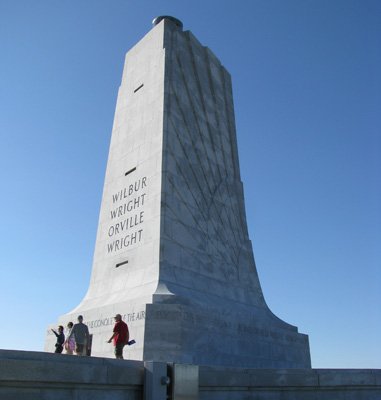As I stand alone in a sandy field near the Atlantic Ocean, I can
hear crickets and katydids calling to each other. A bracing wind
blows across my face. There are, most appropriately, other winged
calls in the distance, as birds dip and soar through the blue sky.
I feel the sun warming the granite stone as I lay my hand against
the huge boulder marking the exact spot where man first slipped the
surly bonds of earth.
“Oh! I have slipped the surly bonds of Earth
And danced the skies on laughter-silvered wings;
Sunward I’ve climbed, and joined the tumbling mirth
of sun-split clouds, – and done a hundred things
You have not dreamed of – wheeled and soared and swung
High in the sunlit silence. Hov’ring there’
I’ve chased the shouting wind along, and flung
My eager craft through footless halls of air …”
~ From “High Flight,” by pilot John Gillespie Magee, Jr., required to be recited by memory by first year cadets at the United States Air Force Academy
As I stand alone in a sandy field near the Atlantic Ocean, I can hear crickets and katydids calling to each other. A bracing wind blows across my face. There are, most appropriately, other winged calls in the distance, as birds dip and soar through the blue sky. I feel the sun warming the granite stone as I lay my hand against the huge boulder marking the exact spot where man first slipped the surly bonds of earth.
It was 105 years ago in 1903 that wind, sand and a dream of flight brought Wilbur and Orville Wright to Kitty Hawk, North Carolina, where a long, narrow and tiny spit of land meets the sea, and the wind has crashed more than 1,000 ships against the shore in spectacular display. You can get a sense of what this place is like in the current Richard Gere movie, “Nights in Rodanthe,” which was filmed in this area. The Wright Brothers made their first flight here because of the strong wind and the soft landing material which would cushion potential spills.
Orville Wright said, “The flight lasted only 12 seconds, but it was nevertheless the first in the history of the world in which a machine carrying a man had risen itself by its own power into the air in full flight, had sailed forward without reduction of speed, and had finally landed at a point as high as that from which it started.”
As I step onto the sandy path of that first flight, I quickly reach the next stone marker 200 feet away where the plane touched back down to earth. I see Orville in my mind’s eye as he then switched places with older brother Wilbur (which brother got to make the first flight was based on a coin toss) and ran along to help balance the wing during take-off. Wilbur launched a second flight of 12 seconds, but this time, the 605-pound Flyer flew 55 extra feet in the same amount of time as Orville’s first flight, going from 120 to 175 feet. Orville switched off to make the third flight that day, and I can almost see the 40-foot Flyer lifting off from the soft sand in front of me as I walk the flight path to 200 feet which Orville flew in 15 seconds.
Being on this road trip on the east coast and touring Kitty Hawk in the Kill Devil Hills of North Carolina (2,963.85 miles from Gilroy), I was surprised to meet a fellow visitor here from Gilroy! Not only that, but the older gentleman by the name of Pemberton Miller told me that he has a pilot’s license signed by Orville Wright in 1929. Orville was serving as chairman of the National Aeronautic Association back then and personally signed Miller’s license. Miller has flown small planes for more than 50 years, working both as a crop duster and training many students over the years. He promises to show me the license when we are back home in Gilroy. Who knew I would find a connection to Gilroy even here in the Outer Banks of North Carolina?
As I walk the final path to the marker for the fourth and final flight that day that changed the world, I look up and see the marker so far in the distance that it is not even in easy walking distance for some of the visitors to the Wright Brothers National Memorial. Wilbur flew for nearly a minute and traveled 852 feet, proving that the Wright brothers were truly masters of the air beyond the short powered hops and glides others had achieved.
The Wright brothers had labored in obscurity for years to solve the problems of how to stabilize and control an aircraft, while simultaneously achieving lift and being able to propel the vehicle forward. Their unique design evolved quickly into the same configuration that virtually all airplanes share to this day. In his lifetime, Orville Wright saw flight progress from 0 to 1,000 mph. It took a mere 66 years for humans to go from the first flight by Orville Wright to landing on the moon.
“Up, up the long, delirious, burning blue
I’ve topped the wind-swept heights with easy grace
Where never lark nor even eagle flew –
And, while with silent lifting mind I’ve trod
The high untrespassed sanctity of space’
Put out my hand, and touched the face of God.”














